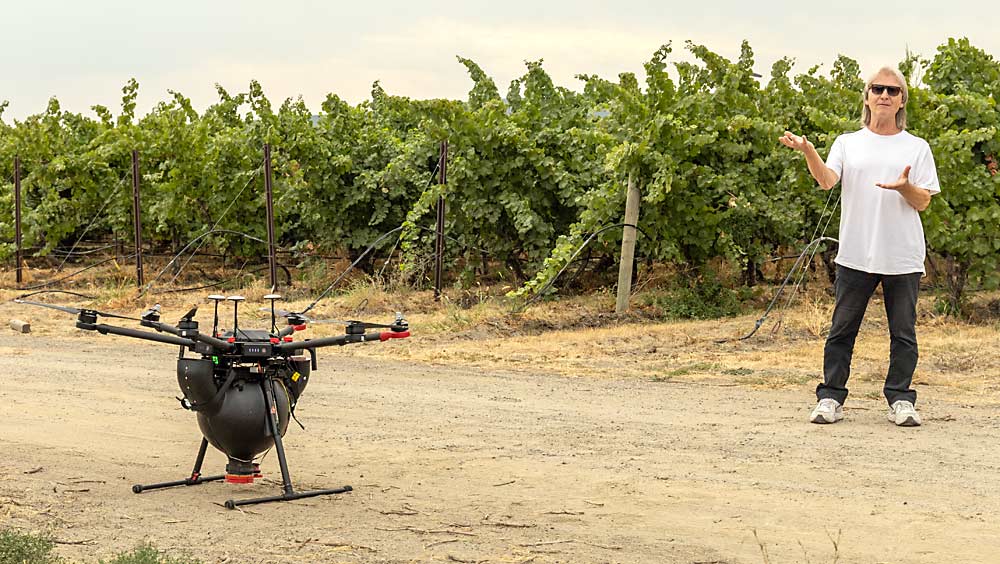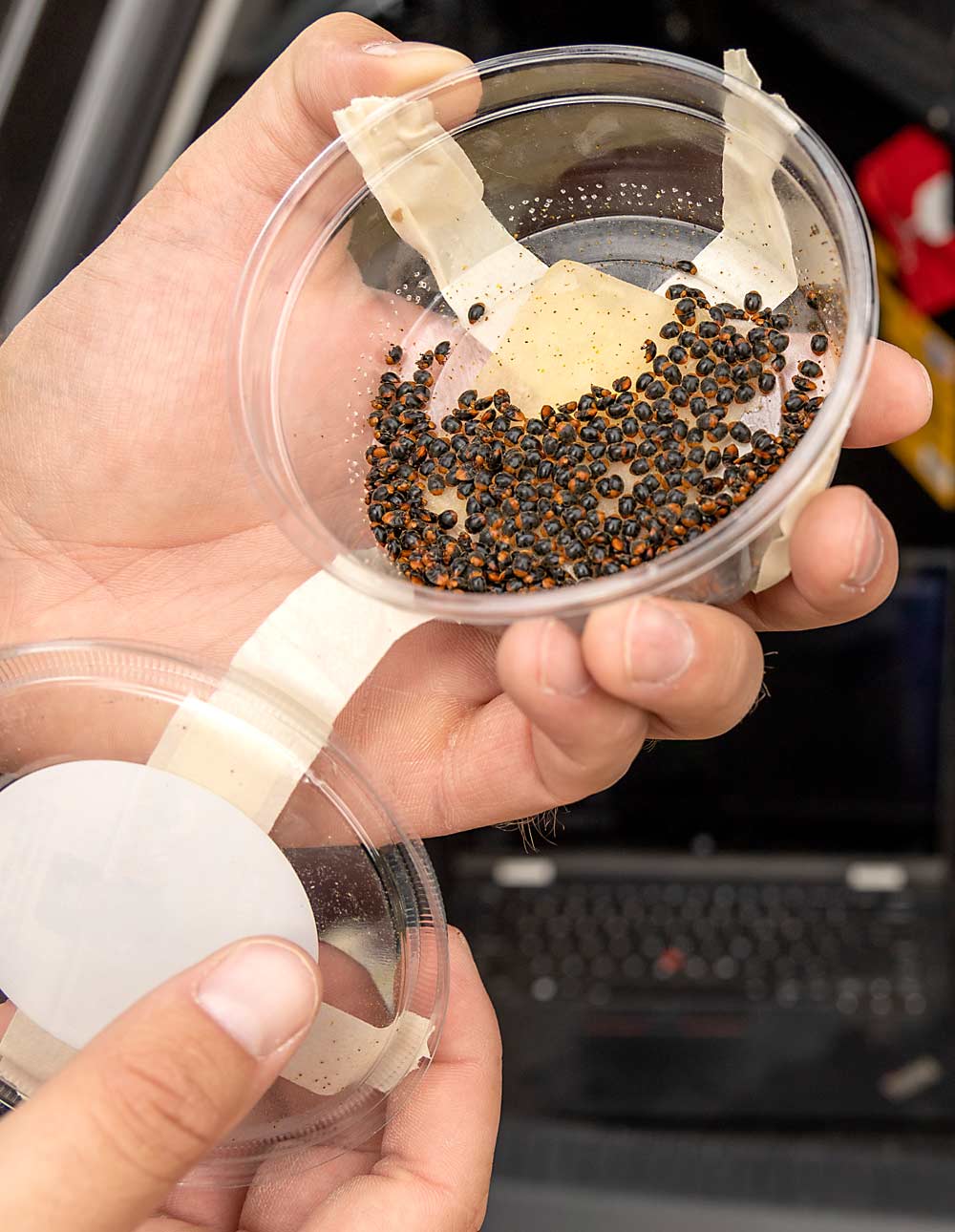
New research indicates that releasing natural enemies by drone, paired with an insect attractant, may improve control of spider mites and grape mealybugs in Washington wine grape vineyards. The findings stem from a one-year demonstration project funded through the research grant program of the Washington State Wine Commission.
Putting good bugs to work in the field is simple in concept but hard in practice. It requires large enough populations of beneficials to control the targeted pest, and those good bugs must remain in place long enough to do their job. And while commercial insectaries offer a variety of species to augment native natural-enemy populations, manual release of beneficials in a vineyard is labor-intensive and costly. Drones recently have been used to release beneficials in agricultural crops and could be an economical and sustainable integrated pest management (IPM) tool for spider mite and grape mealybug control.
IPM combo
The study, led by David James, Washington State University entomologist, was conducted in a commercial wine grape vineyard in Benton City, located in the Red Mountain AVA (American Viticultural Area). James specializes in spider and predatory mite studies and ways to enhance natural-enemy populations in grapes and hops. The drone release of beneficials was performed by UAV-IQ, a private company headquartered in California. The trial’s purpose was to evaluate a novel and sustainable IPM strategy that combines drone-released beneficials with use of methyl salicylate, an insect attractant.
The Washington State Wine Commission hosted a “research-in-action” field day in mid-August to give industry members a firsthand look at the project. About 30 growers, winemakers and other interested parties attended the short demonstration and showed keen interest in the concept.
More than a decade ago, James extensively field-tested methyl salicylate in Eastern Washington vineyards. The compound, which is produced by many plant species and has a fruity, wintergreen odor, showed great promise then as a beneficial arthropod attractant. It is now commercially available under the trade name PredaLure, sold in the form of slow-release sachets.
In the new trial, James wanted to learn if the slow-release dispensers could improve the residence time and sustainability of drone-released beneficials as well as attract a diversity of naturally occurring beneficial insects and mites.
Two beneficial insects obtained from a commercial insectary were released by drone in the project: Cryptolaemus beetles, commonly called mealybug destroyer beetles, and the predatory mite Neoseiulus californicus. Drone releases of both species together were made in mid-June and mid-August.
James assessed the insectary beneficials for mortality and viability before and after drone release and determined the method did not appear to be a significant mortality factor. Yellow sticky traps were used throughout the trial to monitor the attractiveness of methyl salicylate to native beneficials. The trial had four treatments: untreated control, drone-released beneficials, drone-released beneficials plus attractant and attractant only.

Spider mites
Spider mite populations were substantially reduced in all treatment blocks compared to the untreated control. The lowest numbers of spider mites — less than 25 mites per leaf — were counted in the methyl salicylate blocks, with and without drone application of beneficials. But the drone application blocks — averaging 60 mites per leaf — also were well below the number of spider mites in the untreated blocks, which averaged around 240 mites per leaf.
Predator mite numbers were highest in the methyl salicylate treatments, with a mean of 2.5 predatory mites per leaf, followed by the drone-delivered methyl salicylate treatments, with a mean of 1.2 predatory mites per leaf. Few were found in the treatments without the attractant.
This suggests that methyl salicylate dispensers could play a substantial role in improving biological control of spider mites by increasing populations of predatory mites.
Good suppression of spider mites was also observed in the drone-only treatments, even though few predatory mites were found in these treatments.
Most of the predatory mites found during the sampling were native predatory mites and not the drone-released California species of predatory mites. While viability of the insectary-reared California species appeared to be reasonable immediately after release, their low numbers found during post-drone sampling suggest they did not persist well in the vineyard. The California species was chosen because of its significantly lower cost to purchase.
Mealybug observations
Grape mealybug populations were assessed by counting the number of mealybugs on sampled leaves and examinations of grapevine trunks. The number of mealybugs on sampled leaves was lowest in the drone treatment blocks, at 22–25 per leaf, and greatest in the methyl salicylate and control treatments, at 30–34 per leaf. Some data was collected on mature mealybugs, but it was difficult to make accurate counts of immature mealybugs. Although the data suggest that drone releases of the Cryptolaemus lady beetles had moderate impact on mealybug populations, the cooperating grower noted that mealybug population levels in the block were lower than previous years.
James was surprised by the higher number of mealybugs in the methyl salicylate treatment, because methyl salicylate is known to attract many kinds of mealybug predators, including lacewings. The proximity of treatments to each other may have obscured or minimized real effects.
Key findings
The one-year evaluation demonstrated great potential for this novel IPM tactic. One of the biggest surprises was the powerful ability of methyl salicylate to attract substantial numbers of a diversity of beneficial insects and mites in wine grapes. Highlights of the data include:
—Trend of reduced mealybug populations in blocks with drone-released mealybug destroyer beetles.
—Substantial suppression of spider mite populations in all treatment blocks.
—Methyl salicylate attracted a variety of native predators, including green lacewings, long-legged flies, lady beetles and big-eyed bugs.
The protocol for the combination tool of drone-released beneficials with an attractant could benefit from additional refinement, such as replacing the attractant sachets after six weeks instead of use all season long, using predator mites native to Washington, timing the drone releases to avoid high temperatures, and improved mealybug monitoring.
We look forward to sharing additional research results for this promising sustainable pest management strategy.
—by Melissa Hansen






Leave A Comment